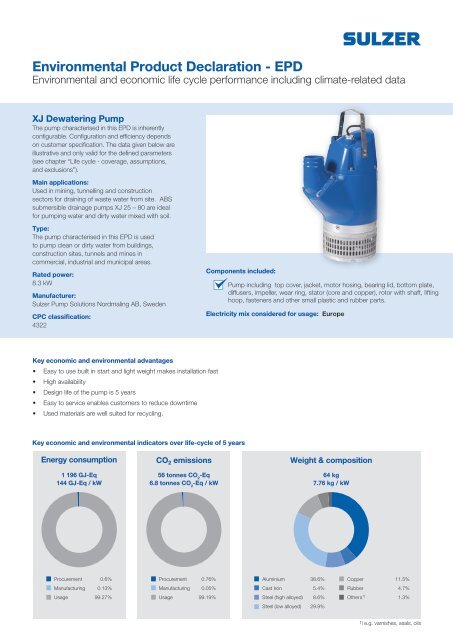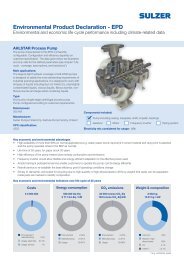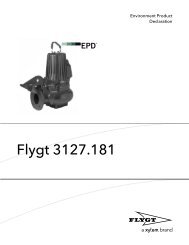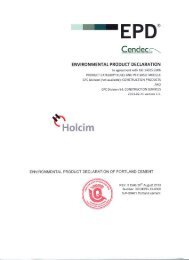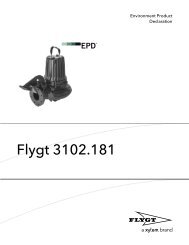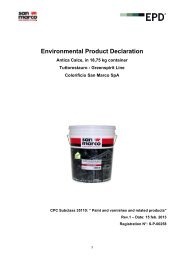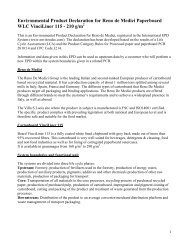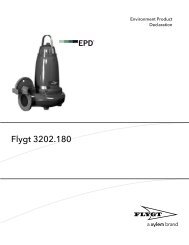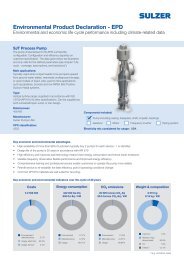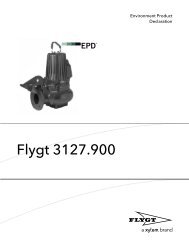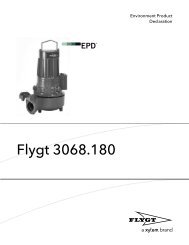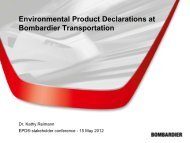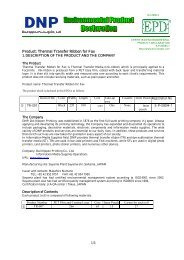Sulzer EPD - XJ Dewatering Pump - The International EPD® System
Sulzer EPD - XJ Dewatering Pump - The International EPD® System
Sulzer EPD - XJ Dewatering Pump - The International EPD® System
Create successful ePaper yourself
Turn your PDF publications into a flip-book with our unique Google optimized e-Paper software.
Functional unit<strong>The</strong> functional unit is defined as 1 kW hydraulic power of the pump at best efficiency point.Composition of the productMaterial kg % 1) kg / kW 2)Aluminium 25 39% 3.00Cast iron 3 5% 0.42Steel (high alloyed) 6 9% 0.67Steel (low alloyed) 19 30% 2.33Copper 7 11% 0.89Rubber 3 5% 0.37Oil 1 1% 0.10Total 64 100% 7.76Rounding has been used to simplify the results tables in the <strong>EPD</strong>.1) By weight. 2) Rated power.<strong>The</strong> pump consists of 39% aluminium, 39% low alloyed and highalloyed steels, 11% copper and 5% of cast iron.<strong>The</strong> indicated quantity of oil refers to the initial fill of the pump,the oil is replaced every second year after installation.Remaining components such as paints and seals amount to lessthan 0.01% of the total weight and have as such been omitted.Material consumption during life cycle per pump 1) (material balance sheet)Non-renewable resources Procurement 2) Manufacturing at <strong>Sulzer</strong> Usage / end of lifeSteel (alloyed), casting and other materialskg kg / kW kg kg / kW kg kg / kW3) 3)for pump 66 7.95 63 7.59 63 7.59for spare parts 3 0.36 0 0.00 0 0.00Oil 3 0.36 3 0.36 3 0.36Waste production (total) n.a. n.a. 10 1.20 66 7.95Hazardous waste n.a. n.a. 0 0.00 3 0.36Municipal waste n.a. n.a. 0 0.00 n.a. n.a.Recycling (total) n.a. n.a. 10 1.20 63 7.59metals (pump) n.a. n.a. 3 0.36 63 7.59metals (spare parts) n.a. n.a. 3 0.361 0 0.00others n.a. n.a. 4 0.48 n.a. n.a.Renewable resources kg kg / kW kg kg / kW kg kg / kWWood (packaging) 40 4.82 40 4.82 40 40Water consumption 4) n.a. n.a. 0 060 7.2 n.a. n.a.n.a.: not available, values per kW related to 8.3 kW rated power. 1) Material resources related to supply of energy to site are not considered. 2) Covers allresources procured during the life cycle by <strong>Sulzer</strong>, including the oil used to operate the pump. 3) Machining during the manufacturing produces recyclable wasteof around 8% by mass of the metals bought in. 4) In manufacturing: used for testing purposes.Primary energy consumption during life cycle (primarily from usage / end of life)Procurement 2) Manufacturing at <strong>Sulzer</strong> Usage / end of life 3) TotalGJ-Eq GJ-Eq/kW GJ-Eq GJ-Eq/kW GJ-Eq GJ-Eq/kW GJ-Eq/ GJ-Eq/kWElectricity 0.7 0.081 0 6) 0 6) 1 117 135 1 117 135Gases 1) 0.0 0.00 0 6) 0 6) 0 0 0.0 0.00Fuel oils 0.0 0.00 0 6) 0 6) 0 0 0.0 0.00Fuels n.a. n.a. 0 0 0 0 0.0 n.a.District heating 8) n.a. n.a. 0 0 0 0 0.0 n.a.Materials 11 1.37 0 0 0 0 11 1.37Transports 0.3 0.039 0.5 0.0651 68 8.19 69 8.290Disposal, waste water n.a. n.a. 0.0
Applied load levels of pump during life cycle<strong>The</strong> applied load levels are summarized in the table below. Based on expected usage characteristics advised by customers, thepump is expected to be operated at full load throughout its life.Phases of load levelDuration of phaseOperating hoursper yearEfficiency ηEffective Ratingyears hours / year % kWPhase 1: full load 5 2 200 61% 9Phase 2: middle load 0 0 0% 0Phase 3: low load 0 0 0% 0Rounding has been used to simplify the results tables in the <strong>EPD</strong>.GlossaryLife cycle assessment, LCA is a management tool for appraisingand quantifying the total environment impact of products or activitiesduring the entire life cycle.Life cycle costs are based on LCAs and cover the total costs of aproduct during the entire life cycle from the extraction of resourcesto the disposal of the product.A Functional Unit is a concept that is used to compare the lifecycle costs of different products on a like-for-like basis.CPC (Central Product Classification) is a UN-based scheme forstatistical division of product categories and service types.EcoInvent Database contains international industrial life cycleinventory data.Acidification occurs through deposition of soluble sulphur andnitrogen compounds from agricultural and combustion processes.Acidification can be harmful to sensitive ecosystems.Eutrophication is the often anthropogenic enrichment of bodiesof water by nitrates and phosphates. This increases the growthof aquatic plants that deoxygenate water and outcompete otheraquatic life.Global warming potential, GWP is the potency of 1 kg of a gasas a radiative forcing agent relative to an emission of 1 kg of carbondioxide over 100 years.Ozone depletion potential, ODPs are calculated as the changethat would result from the emission of 1 kg of a substance comparedto that from the emission of 1 kg of CFC-11 (trichlorofluoromethane).Photochemical ozone creation potential, POCP refers to thechange in of ground level ozone concentration potentially caused bythe emission of 1 kg of a gas compared to that from the emission of1 kg of ethene.SEED is the database that <strong>Sulzer</strong> uses to collect, validate, andreport on social, economic, and ecological data.<strong>Sulzer</strong> <strong>Pump</strong>s<strong>Sulzer</strong> <strong>Pump</strong>s is a world leader in reliable products and innovativepumping solutions. <strong>The</strong> global network of modern manufacturingand packaging facilities together with sales offices, service centresand representatives located close to major markets provide fastresponses to customer needs.<strong>Sulzer</strong> <strong>Pump</strong>s has a long history of providing innovative pumpingsolutions to business partners in the following industries: Oil andGas, Hydrocarbon Processing, Pulp and Paper, Power Generation,General Industry, Chemical Process Industry, Water and WastewaterAll manufacturing sites operate business man-agements systemscertified to ISO 9001, ISO 14001, and OHSAS 18001.Sustainability program of <strong>Sulzer</strong>Sustainability is a key factor for the success of <strong>Sulzer</strong>.<strong>The</strong> company is committed to creating long term economic value,while proactively assuming its social and environmental responsibility.<strong>Sulzer</strong> continuously assesses its sustainability activities.Extensive programs have been initiated to meet the expectationsof <strong>Sulzer</strong>’s stakeholders.Applied standards and limitations<strong>The</strong> document was prepared based on the <strong>EPD</strong> General ProgramInstructions, the PCR for pumps for liquids, liquid elevators andmixers (4322), and the ISO 14025:2010 standard. Environmentalproduct declarations from different programs with different productcategory rules may not be comparable.Verification<strong>The</strong> <strong>EPD</strong> has been externally verified by Atkins Ltd, United Kingdom.<strong>The</strong> verification was undertaken in two sections; a review of therelevant documentation followed by a review of underlying datausing a combination of a desk based review, a site visit andinformation exchange with <strong>Sulzer</strong>. This <strong>EPD</strong> has been verifiedagainst the updated PCR for <strong>Pump</strong>s for Liquids; Liquid Elevatorsand Mixers (CPC Class 4322), valid until 2017-02-15.ReferencesEnvironmental labels and declarations – Type III environmentaldeclarations – Principles, EN ISO 14025:2010, Berlin 2010Product Category Rule (PCR), CPC Class 4322, <strong>Pump</strong>s for Liquids;Liquid Elevators and Mixers, PCR 2011:22, Version 1.0, 2011-12-05Swiss Centre for Life Cycle Inventories, EcoInvent Database 2.1,St. Gallen, 2009<strong>The</strong> <strong>International</strong> <strong>EPD</strong> Cooperation, <strong>EPD</strong> General Instructions forEnvironmental Product Declaration, <strong>EPD</strong> Version 1.0; 2008-02-29.Volkshausen, W. (2003): Methodische Beschreibung und Bewertungder umweltgerechten Gestaltung von Stahlwerkstoffen undStahlerzeugnissen, Dissertation, TU FreibergWuppertal Institut für Klima, Umwelt Energie GmbH (2008):Stahl – ein Werkstoff mitInnovationspotenzial, Ergebnisse des ‚ZukunftsdialogsRohstoffproduktivität und Ressourcenschonung‘, June 2008Further information about products of <strong>Sulzer</strong> <strong>Pump</strong>s can be foundat: www.sulzerpumps.com/productsThis and other <strong>EPD</strong>s are available online at:www.sulzer.com/sustainability.Further information about <strong>Sulzer</strong>: www.sulzer.comFurther information about the <strong>Sulzer</strong> sustainability program:www.sulzer.com/sustainabilityDisclaimer<strong>The</strong> <strong>EPD</strong> has been prepared to the best of <strong>Sulzer</strong> Ltd’s knowledge. However,the data, figures and results are shown for illustration purposes only and<strong>Sulzer</strong> Ltd cannot assume any liability as to the quality of such data, figuresand results. Any warranty or representation, whether express or implied, shallbe excluded.<strong>The</strong> <strong>EPD</strong> is published by <strong>Sulzer</strong> Ltd, Corporate QESH, 8401 Winterthur,Switzerland, © July 02, 2012. For questions and feedback please contactsustainability@sulzer.com.<strong>EPD</strong> program - time of validity of <strong>EPD</strong><strong>The</strong> <strong>International</strong> <strong>EPD</strong> <strong>System</strong>, managed by the <strong>International</strong> <strong>EPD</strong> Consortium(IEC). www.environdec.com.Environmental Product Declarations within the same product category, butfrom different programs may not be comparable.This <strong>EPD</strong> is valid until: 22-02-2016Registration No: S-P-00401 UN CPC 4322Date: 22-02-2013 Version: 0.1


